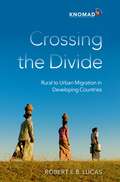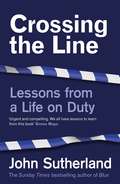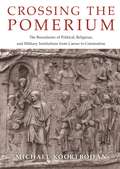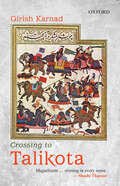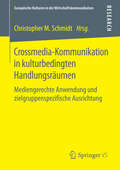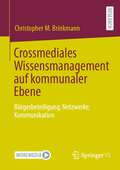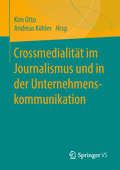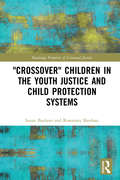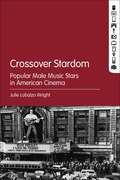- Table View
- List View
Crossing the Divide: Rural to Urban Migration in Developing Countries
by Robert E.B. LucasA comprehensive examination of the nature, causes, and consequences of internal migration in developing countries Despite the key role of rural-urban migration in structural transformation and the persistence of lower living standards in the countryside, active policies to reduce, or even reverse, movement into towns are common in major developing regions. Climate change is shifting the calculus: the resulting erosion to agricultural opportunities, combined with increasing frequency of natural disasters, is already resulting in substantial population displacement, mostly internally and into towns in particular. Crossing the Divide examines the nature, causes, and consequences of population movements between the rural and urban sectors of developing countries. Using nationally representative, micro-level data on individuals from seventy-five countries in Africa, the Asia-Pacific, Latin America, and the Caribbean over the course of several decades, Robert E.B. Lucas moves well beyond existing studies to provide the most comprehensive and definitive treatment of internal migration currently available. Lucas analyzes these data on a country-by-country basis, considering both rural-urban and urban-rural movements, to reassess conventional understandings and offer significant new findings on who moves and who stays, the economic incentives and barriers to moving, the role of social networks, return and onward migration, and the impact of migration on families, especially children.
Crossing the Divide: Rural to Urban Migration in Developing Countries
by Robert E.B. LucasA comprehensive examination of the nature, causes, and consequences of internal migration in developing countries Despite the key role of rural-urban migration in structural transformation and the persistence of lower living standards in the countryside, active policies to reduce, or even reverse, movement into towns are common in major developing regions. Climate change is shifting the calculus: the resulting erosion to agricultural opportunities, combined with increasing frequency of natural disasters, is already resulting in substantial population displacement, mostly internally and into towns in particular. Crossing the Divide examines the nature, causes, and consequences of population movements between the rural and urban sectors of developing countries. Using nationally representative, micro-level data on individuals from seventy-five countries in Africa, the Asia-Pacific, Latin America, and the Caribbean over the course of several decades, Robert E.B. Lucas moves well beyond existing studies to provide the most comprehensive and definitive treatment of internal migration currently available. Lucas analyzes these data on a country-by-country basis, considering both rural-urban and urban-rural movements, to reassess conventional understandings and offer significant new findings on who moves and who stays, the economic incentives and barriers to moving, the role of social networks, return and onward migration, and the impact of migration on families, especially children.
Crossing the Gulf: Love and Family in Migrant Lives
by Pardis MahdaviThe lines between what constitutes migration and what constitutes human trafficking are messy at best. State policies rarely acknowledge the lived experiences of migrants, and too often the laws and policies meant to protect individuals ultimately increase the challenges faced by migrants and their kin. In some cases, the laws themselves lead to illegality or statelessness, particularly for migrant mothers and their children. Crossing the Gulf tells the stories of the intimate lives of migrants in the Gulf cities of Dubai, Abu Dhabi, and Kuwait City. Pardis Mahdavi reveals the interconnections between migration and emotion, between family and state policy, and shows how migrants can be both mobilized and immobilized by their family relationships and the bonds of love they share across borders. The result is an absorbing and literally moving ethnography that illuminates the mutually reinforcing and constitutive forces that impact the lives of migrants and their loved ones—and how profoundly migrants are underserved by policies that more often lead to their illegality, statelessness, deportation, detention, and abuse than to their aid.
Crossing the Human Threshold: Dynamic Transformation and Persistent Places During the Middle Pleistocene (Frames and Debates in Deep Human History)
by Matt Pope John McNabb Clive GambleWhen was the human threshold crossed? What is the evidence for evolving humans and their emerging humanity? This volume explores in a global overview the archaeology of the Middle Pleistocene, 800,000 to 130,000 years ago when evidence for innovative cultural behaviour appeared. The evidence shows that the threshold was crossed slowly, by a variety of human ancestors, and was not confined to one part of the Old World. Crossing the Human Threshold examines the changing evidence during this period for the use of place, landscape and technology. It focuses on the emergence of persistent places, and associated developments in tool use, hunting strategies and the control of fire, represented across the Old World by deeply stratified cave sites. These include the most important sites for the archaeology of human origins in the Levant, South Africa, Asia and Europe, presented here as evidence for innovation in landscape-thinking during the Middle Pleistocene. The volume also examines persistence at open locales through a cutting-edge review of the archaeology of Northern France and England. Crossing the Human Threshold is for the worldwide community of students and researchers studying early hominins and human evolution. It presents new archaeological data. It frames the evidence within current debates to understand the differences and similarities between ourselves and our ancient ancestors.
Crossing the Human Threshold: Dynamic Transformation and Persistent Places During the Middle Pleistocene (Frames and Debates in Deep Human History)
by Matt Pope John McNabb Clive GambleWhen was the human threshold crossed? What is the evidence for evolving humans and their emerging humanity? This volume explores in a global overview the archaeology of the Middle Pleistocene, 800,000 to 130,000 years ago when evidence for innovative cultural behaviour appeared. The evidence shows that the threshold was crossed slowly, by a variety of human ancestors, and was not confined to one part of the Old World. Crossing the Human Threshold examines the changing evidence during this period for the use of place, landscape and technology. It focuses on the emergence of persistent places, and associated developments in tool use, hunting strategies and the control of fire, represented across the Old World by deeply stratified cave sites. These include the most important sites for the archaeology of human origins in the Levant, South Africa, Asia and Europe, presented here as evidence for innovation in landscape-thinking during the Middle Pleistocene. The volume also examines persistence at open locales through a cutting-edge review of the archaeology of Northern France and England. Crossing the Human Threshold is for the worldwide community of students and researchers studying early hominins and human evolution. It presents new archaeological data. It frames the evidence within current debates to understand the differences and similarities between ourselves and our ancient ancestors.
Crossing the Line: Losing Your Mind as an Undercover Cop
by Christian PlowmanAs he rose through the ranks of various departments of the Metropolitan Police, Christian Plowman dreamt of being an undercover cop. When he finally achieved his ambition, becoming one an elite group of officers, the reality of covert work turned his life into a nightmare.To catch criminals, Christian bought and sold drugs with taxpayers’ money, been beaten up, arrested at gunpoint and barricaded in a pub by a gang of marauding gypsies – all in a day’s work. At one stage, he was running almost a dozen mobile phones to keep track of his different identities and had so many aliases that he nearly forgot who he was. He put his life on the line for the job but was to find that being the ‘best of the best’ wasn’t all it was cracked up to be. The pressure became so intense that he even contemplated suicide.Crossing the Line is a visceral, gripping account of what it really takes to be an undercover cop. It exposes how the Met conducts its business behind the scenes and reveals the harsh realities of modern covert police work.
Crossing the Line: Lessons From a Life on Duty
by John SutherlandAs a society, we are captivated by policing; we watch police procedurals and fly-on-the-wall documentaries and absorb the headlines on the rolling news. Yet how much do we really know about the world that policing inhabits and reveals? In his deeply revealing new book, John Sutherland invites us to step behind the cordon tape and bear witness to the things that he has seen in his twenty-five years of service with the Metropolitan Police. Tackling ten of the biggest challenges facing society today - from alcohol abuse, drug addiction and domestic violence to knife crime, terrorism and sexual offences - we are introduced to people who have been pushed to the limits and beyond. In doing so, we gain a clearer sense of what needs to be done to make our neighbourhoods safer and to transform the lives of those we live alongside. Eye-opening, courageous and moving, CROSSING THE LINE is a book that will change the way you see the world around you.
Crossing the Line: Interracial Couples in the South (Non-ser.)
by Maria Tempenis Beth Walton Robert Hartmann McNamaraDespite the increased number of interracial marriages in recent years, Black/White couples still experience a host of problems in American society, particularly in the South. Drawing on extensive interviews with 28 Black/White couples living in the South, this ethnographic study describes the issues and obstacles these couples have to face and documents their overwhelming sense of social isolation. The problems include hostility, encountered while the couple is in public, ranging from stares to outright attacks, as well as a lack of support and ostracization by their families. After discussing the nature of Black/White relationships and the historical implications of interracial couples—beginning with slavery—the authors adopt a life history approach, which allows them to probe deeply into the meaning of the interviewees' responses.
Crossing the Pomerium: The Boundaries of Political, Religious, and Military Institutions from Caesar to Constantine
by Michael KoortbojianA multifaceted exploration of the interplay between civic and military life in ancient RomeThe ancient Romans famously distinguished between civic life in Rome and military matters outside the city—a division marked by the pomerium, an abstract religious and legal boundary that was central to the myth of the city's foundation. In this book, Michael Koortbojian explores, by means of images and texts, how the Romans used social practices and public monuments to assert their capital's distinction from its growing empire, to delimit the proper realms of religion and law from those of war and conquest, and to establish and disseminate so many fundamental Roman institutions across three centuries of imperial rule.Crossing the Pomerium probes such topics as the appearance in the city of Romans in armor, whether in representation or in life, the role of religious rites on the battlefield, and the military image of Constantine on the arch built in his name. Throughout, the book reveals how, in these instances and others, the ancient ideology of crossing the pomerium reflects the efforts of Romans not only to live up to the ideals they had inherited, but also to reconceive their past and to validate contemporary practices during a time when Rome enjoyed growing dominance in the Mediterranean world.A masterly reassessment of the evolution of ancient Rome and its customs, Crossing the Pomerium explores a problem faced by generations of Romans—how to leave and return to hallowed city ground in the course of building an empire.
Crossing the Pomerium: The Boundaries of Political, Religious, and Military Institutions from Caesar to Constantine
by Michael KoortbojianA multifaceted exploration of the interplay between civic and military life in ancient RomeThe ancient Romans famously distinguished between civic life in Rome and military matters outside the city—a division marked by the pomerium, an abstract religious and legal boundary that was central to the myth of the city's foundation. In this book, Michael Koortbojian explores, by means of images and texts, how the Romans used social practices and public monuments to assert their capital's distinction from its growing empire, to delimit the proper realms of religion and law from those of war and conquest, and to establish and disseminate so many fundamental Roman institutions across three centuries of imperial rule.Crossing the Pomerium probes such topics as the appearance in the city of Romans in armor, whether in representation or in life, the role of religious rites on the battlefield, and the military image of Constantine on the arch built in his name. Throughout, the book reveals how, in these instances and others, the ancient ideology of crossing the pomerium reflects the efforts of Romans not only to live up to the ideals they had inherited, but also to reconceive their past and to validate contemporary practices during a time when Rome enjoyed growing dominance in the Mediterranean world.A masterly reassessment of the evolution of ancient Rome and its customs, Crossing the Pomerium explores a problem faced by generations of Romans—how to leave and return to hallowed city ground in the course of building an empire.
Crossing the Racial Divide: Close Friendships Between Black and White Americans (Non-ser.)
by Kathleen KorgenIn interviews in cities and towns across the United States, from New York to Los Angeles, and from Madison to Dallas, members of 40 black and white pairs of friends reflect on how they became friends, how racial issues are addressed, and how their friendships have influenced their views and, in some cases, their actions. Utilizing a sociological framework to examine the friendships, Korgen offers readers a rare glimpse into an even rarer phenomenon and sheds light on important aspects of race relations in America.How do close friendships between blacks and whites develop? Why are cross-racial friendships so rare? How do these friendships navigate the issue of race? Crossing the Racial Divide answers these questions through a lively discussion of the problems and issues and through the voices of members of cross-racial friendships. In interviews in cities and towns across the United States, from New York to Los Angeles, and from Madison to Dallas, members of 40 black and white pairs of friends reflect on how they became friends, how racial issues are addressed, and how their friendships have influenced their views and, in some cases, their actions. Utilizing a sociological framework to examine the friendships, Korgen offers readers a rare glimpse into an even rarer phenomenon and sheds light on important aspects of race relations in America.Challenging both the traditional notion that blacks and whites are opposites and the increasingly popular notion of colorblindness, the author reveals that, while close black/white friendships follow the concept of homophily, we cannot just wish away the tensions and disparities that exist between most white and black Americans. Cross-racial friendships provide a unique perspective that makes racism and racial separation both more visible and more vulnerable. Put into sociological context, the stories revealed in this book make evident the institutional barriers existing between most black and white Americans and offer insight into the means to dismantle them.
Crossing the Thinnest Line: How Embracing Diversity-from the Office to the Oscars-Makes America Stronger
by Lauren Leader-ChiveeFROM THE VERY FOUNDING OF OUR NATION, diversity has been one of our greatest strengths but also the greatest source of conflict. In less than a generation, America will become "minority-majority," and the world economy, already interconnected, will be even more globalized. The stakes for how we handle this evolution couldn't be higher. Will diversity be a source of growth, prosperity, and progress-or perpetual division and strife? America has the potential to realize huge gains economically and socially by more fully capitalizing on diversity, but significant challenges remain and it's a problem that all Americans should be focused on solving. Despite tremendous progress, women and minorities still face barriers to accessing the full promise of the American dream. It doesn't have to be this way. Many of the solutions are right in front of us, and many exceptional, committed Americans are doing their part to make a difference. In the twenty-first century, nations will prosper only insofar as they embrace and celebrate the individuals, organizations, and collective efforts to advance every kind of diversity. Lauren Leader-Chivée believes America must lead the way. In CROSSING THE THINNEST LINE, she explores the state of our diverse union and shares important stories of progress and potential, highlighting those who are crossing dividing lines of race, gender, culture, and political party to build a more united and prosperous nation. Her revelations will transform the discussion and set the agenda for America's progress on these critical issues. A work of originality and ambition, CROSSING THE THINNEST LINE changes our understanding of diversity and offers lessons to change our lives and our country.
Crossing the Thinnest Line: How Embracing Diversity-from the Office to the Oscars-Makes America Stronger
by Lauren Leader-ChiveeFROM THE VERY FOUNDING OF OUR NATION, diversity has been one of our greatest strengths but also the greatest source of conflict. In less than a generation, America will become "minority-majority," and the world economy, already interconnected, will be even more globalized. The stakes for how we handle this evolution couldn't be higher. Will diversity be a source of growth, prosperity, and progress-or perpetual division and strife? America has the potential to realize huge gains economically and socially by more fully capitalizing on diversity, but significant challenges remain and it's a problem that all Americans should be focused on solving. Despite tremendous progress, women and minorities still face barriers to accessing the full promise of the American dream. It doesn't have to be this way. Many of the solutions are right in front of us, and many exceptional, committed Americans are doing their part to make a difference. In the twenty-first century, nations will prosper only insofar as they embrace and celebrate the individuals, organizations, and collective efforts to advance every kind of diversity. Lauren Leader-Chivée believes America must lead the way. In CROSSING THE THINNEST LINE, she explores the state of our diverse union and shares important stories of progress and potential, highlighting those who are crossing dividing lines of race, gender, culture, and political party to build a more united and prosperous nation. Her revelations will transform the discussion and set the agenda for America's progress on these critical issues. A work of originality and ambition, CROSSING THE THINNEST LINE changes our understanding of diversity and offers lessons to change our lives and our country.
Crossing to Talikota
by Girish KarnadThe year is 1565. Devastation reigns over the once-renowned Vijayanagara Empire. Its powerful army has buckled under the assault of four minor Sultanates. Within a few hours of the Battle of Talikota, the political contours of southern India have been radically altered, the rich and prosperous capital city, Vijayanagara, plundered, decimated, and abandoned. It would lie uninhabited for centuries, known thereafter only as ‘the ruins of Hampi’. Behind this cataclysm swirls a saga of ruthless ambition, caste, and religious conflict, family intrigue and betrayal, driven by the power hungry ‘Aliya’ Ramaraya, son-in-law of the emperor Krishna Deva Raya. A brilliant strategist and diplomat, he ruled the empire with an iron hand but was unacceptable to his own people as the legitimate heir because he lacked royal blood. In Crossing to Talikota, Girish Karnad focuses on the interplay of characters who have been ignored by history even though they played integral roles in shaping one of its darkest chapters.
Crossmedia-Kommunikation in kulturbedingten Handlungsräumen: Mediengerechte Anwendung und zielgruppenspezifische Ausrichtung (Europäische Kulturen in der Wirtschaftskommunikation)
by Christopher M. SchmidtDie AutorInnen dieses Sammelbandes behandeln die Voraussetzungen und Möglichkeiten effizienter Kommunikation vor allem im Bereich crossmedialer Vermittlung. Neben grundsätzlichen Bedingungen für die Gestaltbarkeit von verbaler, nonverbaler, mündlicher und schriftlicher Kommunikation analysieren die BeiträgerInnen spezifische Fälle der Interaktion mit Zielgruppen verschiedener Art. Die Artikel aus verschiedenen Ländern behandeln die Bereiche der internen und externen Organisationskommunikation. Es werden kulturelle Handlungsbedingungen im unternehmens- und im landeskulturellen Kontext ergründet. Die Beiträge zeigen mit welchen kultur- und medienbedingten Besonderheiten das Kommunikationsmanagement rechnen muss. Einzelfallanalysen geben konkrete Handlungshinweise und veranschaulichen die Forschungsergebnisse anhand von Beispielen aus Profit- und Non-Profit-Organisationen.
Crossmediales Wissensmanagement auf kommunaler Ebene: Bürgerbeteiligung, Netzwerke, Kommunikation
by Christopher M. BrinkmannIn diesem Buch werden die Bürgerbeteiligung auf kommunaler Ebene und das Wissen, das über Kommunikation in den Netzwerken der Akteure der politischen Partizipation und des zivilgesellschaftlichen Engagements tradiert wird, aus medien- und kommunikationswissenschaftlicher Sicht betrachtet. Der Fokus der Untersuchung liegt auf dialogorientiert-informellen Verfahren und dem medienübergreifenden Abrufen, Akkumulieren, Generieren und Ausbilden von Wissen in der Bürgerbeteiligung über ein crossmediales Wissensmanagement. Aus der Zusammenführung normativ-theoretischer Überlegungen und der empirischen Befunde einer Feldforschung im Raum Mittweida wird das Konzept der wissensorientierten Bürgerkommune entwickelt. Dafür werden fünf Bausteine vorgeschlagen, die bei der Etablierung von dialogorientiert-informeller Bürgerbeteiligung sowie einem crossmedialen Wissensmanagement auf kommunaler Ebene helfen können. Die normativ-theoretischen Überlegungen, die empirischen Befunde und auch die Konzeptentwicklung sind sowohl für den wissenschaftlichen Diskurs um die Förderung von Bürgerbeteiligung als auch für Praktiker der Zivilgesellschaft und der politisch-administrativen Ebene in Kommunen relevant.
Crossmedialität im Journalismus und in der Unternehmenskommunikation
by Kim Otto Andreas KöhlerCrossmedialität ‒ das Kreuzen der Medien ‒ ist einer der großen Trends im Journalismus und in der Unternehmenskommunikation. Inhalte werden über mehrere Plattformen publiziert, Organisation, Planung, Recherche und Qualitätssicherung passen sich an. Medienkonvergenz wird von einem theoretischen Konzept zur Medienpraxis. Dieser Band beschreibt den crossmedialen Wandel und erfasst dessen Stand. Dies erfolgt sowohl auf theoretischer als auch auf empirischer Ebene. Zudem werden die Auswirkungen des crossmedialen Wandels auf die Rezeption von Medien empirisch beschrieben und Konzepte dargestellt.
Crossover als Inszenierungsstrategie: Doing Pop, Doing Classical Music, Doing Mixed Genres (Edition Kulturwissenschaft #225)
by Clara-Franziska PetryWie grenzt sich klassische Musik von Popmusik ab? Und welche Rolle spielen dabei performative Inszenierungsstrategien? Mit einem praxeologischen Ansatz arbeitet Clara-Franziska Petry Inszenierungsstrategien als konstituierende Prozesse für Musikgenres heraus und entwirft eine Aufführungsanalyse von Stars. Im Zentrum stehen dabei sogenannte Crossover-Phänomene, die Genregrenzen generell aufbrechen. Die Inszenierungstechniken von Authentizität, Virtuosität, Popularität, Kulturalität, Korporalität und Lokalität ermöglichen einen Vergleich von E- und U-Musik, der nicht auf der Ebene des musikalischen Materials, sondern auf performativer Ebene basiert.
'Crossover' Children in the Youth Justice and Child Protection Systems (Routledge Frontiers of Criminal Justice)
by Susan Baidawi Rosemary Sheehan"Crossover" Children in the Youth Justice and Child Protection Systems explores the outcomes faced by the group of children who experience involvement with both child protection and youth justice systems across several countries, including the United States, United Kingdom, Canada, New Zealand, and Australia. Situated against a backdrop of international evidence and grounded in a two-year study with the Children’s Court in Victoria, Australia, this book presents a cohesive picture of the backgrounds, characteristics, and pathways traversed by crossover children. It presents statistical data from 300 crossover Children’s Court case files, alongside the expert evidence of 82 professionals, to generate a comprehensive picture of the lives of crossover children, and the individual and systemic challenges that they face. The book investigates the crucial question of why some children involved with child welfare systems experience particularly poor criminal justice outcomes, demonstrating how the convergence of cumulative childhood adversity, complex support needs, and systemic disadvantage produces acutely damaging outcomes for some crossover youth. It outlines the implications of the study, including how these findings might shape diversion and differential justice system responses to child protection-involved youth, and the innovative approaches adopted internationally to avert the care to custody pathway. This book is internationally relevant and will be of great interest to students and scholars of criminology and law, social work, psychology, and sociology, as well as legal, welfare, and government agencies and policy developers, non-government peak bodies and services, professional probation services, case managers, health and mental health services, disability and drug treatment agencies, and others who work with both young offenders and the design and implementation of policy and legislation.
'Crossover' Children in the Youth Justice and Child Protection Systems (Routledge Frontiers of Criminal Justice)
by Susan Baidawi Rosemary Sheehan"Crossover" Children in the Youth Justice and Child Protection Systems explores the outcomes faced by the group of children who experience involvement with both child protection and youth justice systems across several countries, including the United States, United Kingdom, Canada, New Zealand, and Australia. Situated against a backdrop of international evidence and grounded in a two-year study with the Children’s Court in Victoria, Australia, this book presents a cohesive picture of the backgrounds, characteristics, and pathways traversed by crossover children. It presents statistical data from 300 crossover Children’s Court case files, alongside the expert evidence of 82 professionals, to generate a comprehensive picture of the lives of crossover children, and the individual and systemic challenges that they face. The book investigates the crucial question of why some children involved with child welfare systems experience particularly poor criminal justice outcomes, demonstrating how the convergence of cumulative childhood adversity, complex support needs, and systemic disadvantage produces acutely damaging outcomes for some crossover youth. It outlines the implications of the study, including how these findings might shape diversion and differential justice system responses to child protection-involved youth, and the innovative approaches adopted internationally to avert the care to custody pathway. This book is internationally relevant and will be of great interest to students and scholars of criminology and law, social work, psychology, and sociology, as well as legal, welfare, and government agencies and policy developers, non-government peak bodies and services, professional probation services, case managers, health and mental health services, disability and drug treatment agencies, and others who work with both young offenders and the design and implementation of policy and legislation.
Crossover Stardom: Popular Male Music Stars in American Cinema
by Julie Lobalzo WrightCrossover Stardom: Popular Male Stars in American Cinema focuses on male music stars who have attempted to achieve film stardom. Crossover stardom can describe stars who cross from one medium to another. Although 'crossover' has become a popular term to describe many modern stars who appear in various mediums, crossover stardom has a long history, going back to the beginning of the cinema. Lobalzo Wright begins with Bing Crosby, a significant Hollywood star in the studio era; moving to Elvis Presley in the 1950s and 1960s, as the studio system collapsed; to Kris Kristofferson in the New Hollywood period of the 1970s; and ending with Will Smith and Justin Timberlake, in the contemporary era, when corporate conglomerates dominate Hollywood. Thus, the study not only explores music stardom (and music genres) in various eras, and masculinity within these periods, it also surveys the history of American cinema from industrial and cultural perspectives, from the 1930s to today.
Crossover Stardom: Popular Male Music Stars in American Cinema
by Julie Lobalzo WrightCrossover Stardom: Popular Male Stars in American Cinema focuses on male music stars who have attempted to achieve film stardom. Crossover stardom can describe stars who cross from one medium to another. Although 'crossover' has become a popular term to describe many modern stars who appear in various mediums, crossover stardom has a long history, going back to the beginning of the cinema. Lobalzo Wright begins with Bing Crosby, a significant Hollywood star in the studio era; moving to Elvis Presley in the 1950s and 1960s, as the studio system collapsed; to Kris Kristofferson in the New Hollywood period of the 1970s; and ending with Will Smith and Justin Timberlake, in the contemporary era, when corporate conglomerates dominate Hollywood. Thus, the study not only explores music stardom (and music genres) in various eras, and masculinity within these periods, it also surveys the history of American cinema from industrial and cultural perspectives, from the 1930s to today.
Crossover Stars in the Hindi Film Industry: Globalizing Pakistani Identity
by Dina KhdairThis book explores the cultural politics of Pakistani crossover stardom in the Hindi film industry as a process of both assimilation and “Otherness”. Analysing the career profiles of three crossover performers – Ali Zafar, Fawad Khan, and Mahira Khan – as a relevant case study, it unites critical globalization studies with soft power theory in exploring the potential of popular culture in conflict resolution. The book studies the representation and reception of these celebrities, while discussing themes such as the meaning of being a Pakistani star in India, and the consequent identity politics that come into play. As the first comprehensive study of Pakistani crossover stardom, it captures intersections between political economy, cultural representation, and nationalist discourse, at the same time reflecting on larger questions of identity and belonging in an age of globalization. Crossover Stars in the Hindi Film Industry will be indispensable to researchers of film studies, media and cultural studies, popular culture and performance, peace and area studies, and South Asian studies. It will also be of interest to enthusiasts of Indian cinematic history.
Crossover Stars in the Hindi Film Industry: Globalizing Pakistani Identity
by Dina KhdairThis book explores the cultural politics of Pakistani crossover stardom in the Hindi film industry as a process of both assimilation and “Otherness”. Analysing the career profiles of three crossover performers – Ali Zafar, Fawad Khan, and Mahira Khan – as a relevant case study, it unites critical globalization studies with soft power theory in exploring the potential of popular culture in conflict resolution. The book studies the representation and reception of these celebrities, while discussing themes such as the meaning of being a Pakistani star in India, and the consequent identity politics that come into play. As the first comprehensive study of Pakistani crossover stardom, it captures intersections between political economy, cultural representation, and nationalist discourse, at the same time reflecting on larger questions of identity and belonging in an age of globalization. Crossover Stars in the Hindi Film Industry will be indispensable to researchers of film studies, media and cultural studies, popular culture and performance, peace and area studies, and South Asian studies. It will also be of interest to enthusiasts of Indian cinematic history.
Crossovers: Anti-zionism and Anti-semitism
by Shlomo SharanCrossovers compares Jewish anti-Zionism and Palestinian anti-Semitism from political and philosophical points of view. The authors' goal is to expose what is unique about these phenomena, and what they share, so that both ideologies and their practical impact can be better understood.The authors identify a symbiotic relationship between anti-Semitic Palestinian doctrines and those Jews who are anti-Zionists. There has been a great deal of research on these as separate phenomena, but there has thus far been no research that has noted their similarities. Palestinian anti- Semitism and Jewish anti-Zionism may stem from different sources, but they have similar consequences. Palestinian views derive from religious Islamic as well as nationalist- Arab roots, while the views of anti-Zionist Jews grew out of an ideological-Marxist-Trotskyite background. But both share a common goal: the destruction of the Jewish-Zionist nation, and a common strategy, to achieve a bi-national state as a first stage in the march to this goal.Jewish history is replete with examples of how Jews have ignored repeated threats and acts of violence against them. That characteristic of Jews reflects their Messianic belief, but it lacks a basis in history. That belief has resisted change even in the face of threats that were obvious and that have endangered Jewish lives in the past. Contemporary anti-Zionists share this optimistic outlook. Paradoxically, while the Jewish-Zionist State of Israel contends in public that another Holocaust will not happen and is patently impossible, the lesson of recent Jewish history is that a Holocaust can happen again. This work is unrelenting in its criticisms and tough minded in its assessments of the future. It merits careful, serious reading.
